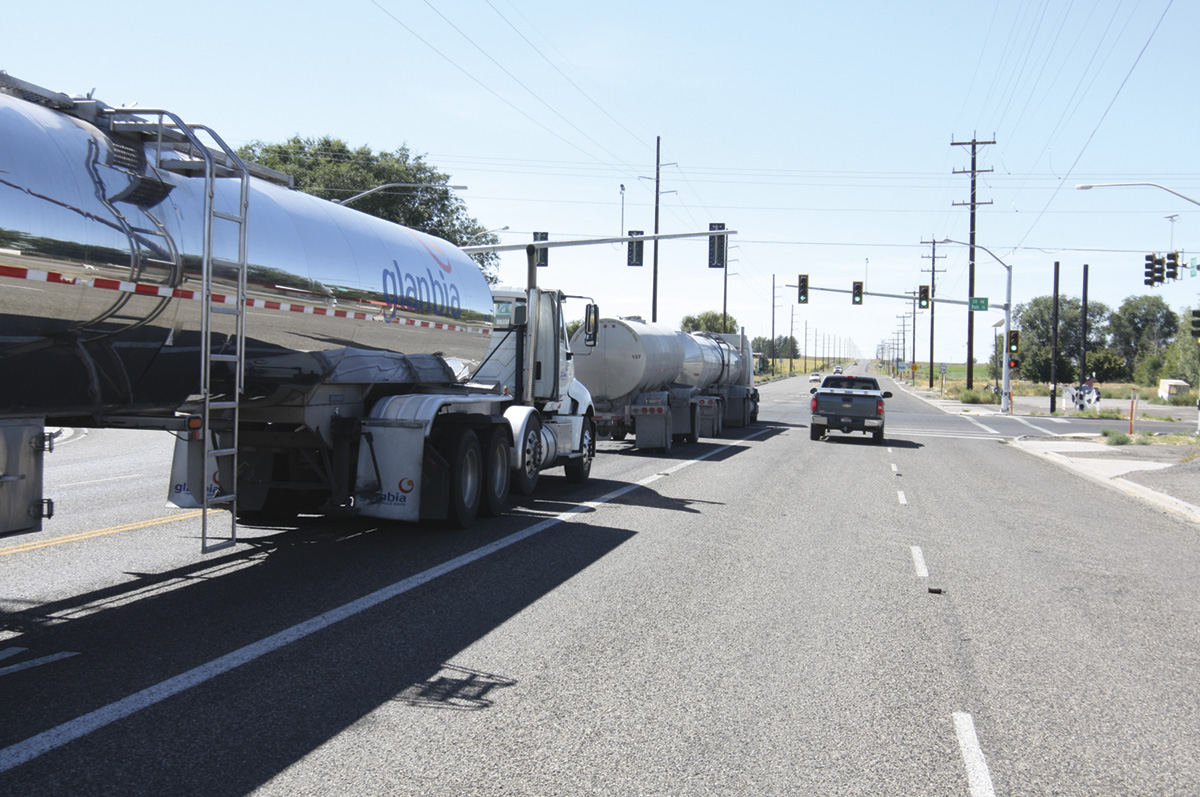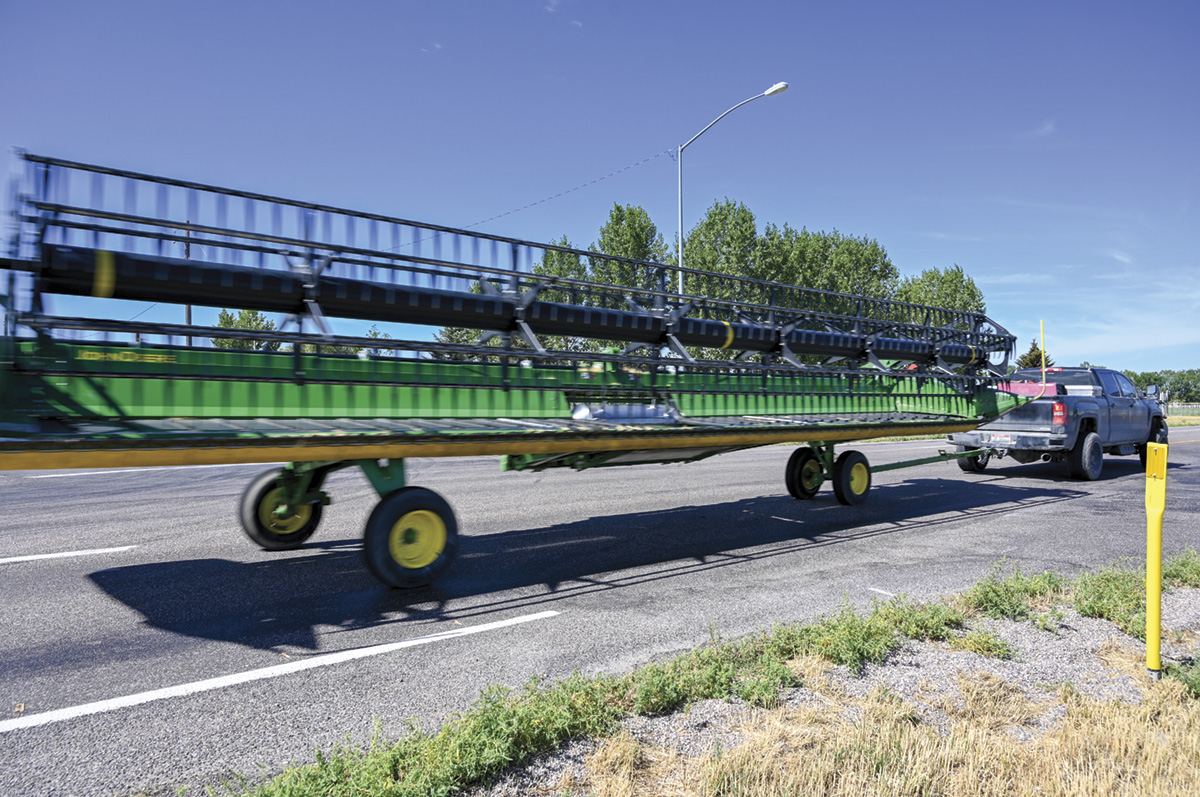With 24,600 farms and ranches in Idaho, accessing remote fields and moving commodities to market place a big demand on the roadways. Never is that so obvious as when harvest is in full swing and motorists find themselves sharing the roads with trucks, combines and other large equipment.
While many of the state’s 28,000 miles of roadway are rural routes falling under the jurisdiction of local highway districts, at some point most farmers have to access a state highway or even interstate. This can be a daunting prospect with a slow-moving combine or oversized implement.
However, producers are not the only ones with ag traffic challenges on their radar. “We’re all about safety and sharing the road with industry,” says Mark Pfeifer, D2 public information officer for the Idaho Transportation Department (ITD). “Ag is the lifeline of our state. We need to get food on tables.”
Mapping out the big loads
To that end, says Pfeifer, agricultural needs are some of the many factors ITD considers in planning and management. “There is a lot of collaboration between entities,” he says. This begins with basic road geometry and holds true all the way to the planning and permitting process for large loads.
While 105,500 pounds is the “normal” maximum weight on the state system, permitted trucks, including those carrying heavy ag loads, may weigh up to 129,000 pounds (with some restrictions, such as over some bridges). However, in areas such as the Twin Falls Highway District, the need for these heavy loads extends well beyond the state highway system.
“Agriculture is the backbone of our area,” says Kenny Spencer, Twin Falls Highway District director. “We have to make accommodations.” That means finding ways for these extra-heavy trucks to safely traverse state and local roads, carrying commodities such as sugarbeets and milk from farm to factory.

Glanbia is one of the many added-value companies that works with producers in the state and trucks a lot of product over the highway system. This truck was spotted near Twin Falls on State Highway 26. Photo courtesy of the Idaho Transportation Department.
“We work with them to route where they’re going,” says Spencer of the trucks permitted for 129,000 pounds. The road district issues annual overweight or oversize permits within their jurisdiction for agricultural and other applications, and works with the permit holders to make sure trucks and equipment can safely cross bridges and clear stoplights, cables and lines in their path. “We’re also working with the state to keep everybody following the rules,” says Spencer. The effort reduces trips over the road system and exemplifies the working relationship between state and local officials and ag industry.
Transportation organizations may also be called in to comment on conditional use permit applications. Big projects such as building new potato cellars sometimes require big loads and odd working hours. The county offers conditional use permit projects for such jobs, with input required from various entities, including the local highway district or ITD, depending on which has jurisdiction.
From routes to reflectors
But the consideration for ag needs starts much earlier than the permitting process. It goes back as far as basic road route planning. “ITD planners and engineers will determine the road geometry to reduce curves wherever possible,” says Pfeifer. “Straighter stretches of roadway are typically safer and more suitable for larger farm equipment.”
The curves in question can include both horizontal turns and vertical elevation changes. Both affect the line of sight while driving. Line of sight, in turn, influences how safe it is for traffic to pass slower-moving vehicles or for large equipment to pull onto the roadway.
Where line of sight cannot be improved – or where heavy traffic often prevents safe passing of slow vehicles – passing lanes may improve travel in ag corridors. Drivers between the northern and southern portions of the state will find a passing lane being constructed in stages on U.S. Highway 95 in Culdesac Canyon. Pfeifer says this work was planned with agricultural equipment and truck traffic in mind.
Even with passing lanes in place, oversized vehicles may require more than one lane. This is where shoulder width and strength come into play. “Farmers oftentimes must travel on the highway. By widening the shoulder, it can reduce how many lanes the equipment needs to take up during planting and harvest season,” Pfeifer says.

Very large equipment is “broken down” as much as possible before taking it down public roadways. Combine headers, such as this one on Interstate 86 near American Falls, are a prime example. Photo courtesy of the Idaho Transportation Department.
Not all shoulders are made for bearing this type of use, however, and ITD gives special consideration to shoulder weight limit in agriculture-heavy areas. For example, Pfeifer says, “When designing the concrete shoulder on U.S. Highway 95 outside of Cottonwood, engineers calculated a combine’s gross weight so that the roadway can safely handle the load rating.”
For other challenges, a relatively small change can make a big difference for vehicles that need a little more space. “For several sections of the highway … ITD has opted use to fiberglass delineators that will simply flex when hit and stay upright,” says Pfeifer. “This model of delineators allows farmers to use more of the shoulder when necessary and reduces the amount that may need to be replaced by ITD operations crews.”
Beyond special considerations, ordinary road maintenance, although not specific to agriculture, is still critical for keeping agriculture moving. Whether the problem is ice or washouts, on highways or local roads, keeping transportation routes open means producers can feed livestock, tend crops and transport animal and plant commodities to market.
Sharing the road
As summer road work season meets harvest, ITD and local highway districts are ramping up efforts to reduce congestion. “We do a lot of social media reminders,” says Pfeifer.
Meanwhile, producers in Spencer’s district are reminded to remove headers, use pilot vehicles and try to avoid peak commute hours when possible. But the reminders are just that: a reminder of practices most are doing already. “Producers try to dodge busy, busy roads,” says Spencer. “Everybody tries to limit exposure.”









